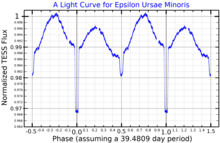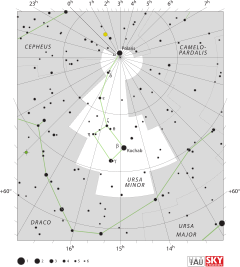Epsilon Ursae Minoris
| Observation data Epoch J2000.0 Equinox J2000.0 (ICRS) | |
|---|---|
| Constellation | Ursa Minor |
| Right ascension | 16h 45m 58.24168s[1] |
| Declination | +82° 02′ 14.1233″[1] |
| Apparent magnitude (V) | +4.19[2] |
| Characteristics | |
| Spectral type | G5 III + A8-F0 V[3] |
| U−B color index | +0.55[4] |
| B−V color index | +0.89[4] |
| Variable type | Eclipsing[2] and RS CVn[5] |
| Astrometry | |
| Radial velocity (Rv) | −10.57±0.40[6] km/s |
| Proper motion (μ) | RA: +19.47[1] mas/yr Dec.: +2.61[1] mas/yr |
| Parallax (π) | 10.73 ± 0.39 mas[1] |
| Distance | 300 ± 10 ly (93 ± 3 pc) |
| Absolute magnitude (MV) | −0.922[7] |
| Orbit[8] | |
| Period (P) | 39.48042±0.00012[3] |
| Eccentricity (e) | 0.04 |
| Periastron epoch (T) | 2433083.47 JD |
| Argument of periastron (ω) (secondary) | 323.5° |
| Semi-amplitude (K1) (primary) | 31.8 km/s |
| Details | |
| ε UMi A | |
| Surface gravity (log g) | 3.21±0.08[3] cgs |
| Temperature | 5,215±47[3] K |
| Metallicity [Fe/H] | −0.25±0.04[3] dex |
| Rotational velocity (v sin i) | 25.6[3] km/s |
| Other designations | |
| Database references | |
| SIMBAD | data |
Epsilon Ursae Minoris (ε Ursae Minoris) is a binary star[10] system in the northern circumpolar constellation of Ursa Minor. It is visible to the naked eye with a combined apparent visual magnitude of 4.19.[2] Based upon an annual parallax shift of 10.73 mas as seen from the Earth, it is located around 300 light years from the Sun. The pair are drawing nearer to the Sun with a radial velocity of −10.57 km/s.[6]

This system forms a detached,[5] single-lined spectroscopic binary[3] with an orbital period of 39.5 days and a low eccentricity of 0.04.[8] Its binary nature was discovered in 1899 by American astronomer W. W. Campbell and the first orbital determination was made in 1910 by Canadian astronomer J. S. Plaskett.[12] The orbital plane is nearly aligned with the line of sight to the Earth, so the pair forms an eclipsing binary. The primary eclipse has a minimum of 4.23 in magnitude, while the secondary minimum is magnitude 4.21.[2] This eclipsing behavior was discovered by German astronomer P. Guthnick using observations between 1946 and 1947.[12]
The primary is an evolved G-type giant star with a stellar classification of G5 III. The secondary is a main sequence star with a class in the range A8-F0 V.[3] One of the pair is an active RS Canum Venaticorum type variable star,[5] which is causing the net brightness to vary with a period that matches the orbital period of the binary. The primary has a high projected rotational velocity of 25.6 km/s,[3] which is likely the result of synchronization effects from tidal interaction with the secondary.[13]
Epsilon Ursae Minoris has a visual companion: a magnitude 12.32 star at an angular separation of 77.0 arc seconds along a position angle of 2°, as of 2014.[14]
References
[edit]- ^ a b c d e van Leeuwen, F. (2007), "Validation of the new Hipparcos reduction", Astronomy and Astrophysics, 474 (2): 653–664, arXiv:0708.1752, Bibcode:2007A&A...474..653V, doi:10.1051/0004-6361:20078357, S2CID 18759600.
- ^ a b c d Avvakumova, E. A.; et al. (October 2013), "Eclipsing variables: Catalogue and classification", Astronomische Nachrichten, 334 (8): 860, Bibcode:2013AN....334..860A, doi:10.1002/asna.201311942, hdl:10995/27061
- ^ a b c d e f g h i Strassmeier, K. G.; et al. (October 2012), "Rotation, activity, and lithium abundance in cool binary stars", Astronomische Nachrichten, 333 (8): 663, arXiv:1208.3741, Bibcode:2012AN....333..663S, doi:10.1002/asna.201211719, S2CID 118450304.
- ^ a b Nicolet, B. (1978), "Photoelectric photometric Catalogue of homogeneous measurements in the UBV System", Astronomy and Astrophysics Supplement Series, 34: 1–49, Bibcode:1978A&AS...34....1N.
- ^ a b c Redfield, S.; et al. (June 2006), "A Cycle-4 Survey of RS CVn Binary Systems", in Sonneborn, G.; Moos, H.; Andersson, B.-G. (eds.), Astrophysics in the Far Ultraviolet: Five Years of Discovery with FUSE ASP Conference Series, Vol. 348, Proceedings of the Conference held 2-6 August, 2004 in Victoria, British Columbia, Canada, vol. 348, p. 269, Bibcode:2006ASPC..348..269R.
- ^ a b Karataș, Yüksel; Bilir, Selçuk; Eker, Zeki; Demircan, Osman; Liebert, James; Hawley, Suzanne L.; Fraser, Oliver J.; Covey, Kevin R.; Lowrance, Patrick; Kirkpatrick, J. Davy; Burgasser, Adam J. (2004). "Kinematics of chromospherically active binaries and evidence of an orbital period decrease in binary evolution". Monthly Notices of the Royal Astronomical Society. 349 (3): 1069–1092. arXiv:astro-ph/0404219. Bibcode:2004MNRAS.349.1069K. doi:10.1111/j.1365-2966.2004.07588.x. S2CID 15290475.
- ^ Böhm-Vitense, Erika; et al. (December 2000), "Ultraviolet Emission Lines in BA and Non-BA Giants", The Astrophysical Journal, 545 (2): 992–999, Bibcode:2000ApJ...545..992B, doi:10.1086/317850.
- ^ a b Pourbaix, D.; et al. (2004), "SB9: The Ninth Catalogue of Spectroscopic Binary Orbits", Astronomy & Astrophysics, 424 (2): 727–732, arXiv:astro-ph/0406573, Bibcode:2004A&A...424..727P, doi:10.1051/0004-6361:20041213, S2CID 119387088.
- ^ "eps UMi". SIMBAD. Centre de données astronomiques de Strasbourg. Retrieved 2017-09-14.
{{cite web}}: CS1 maint: postscript (link) - ^ Eggleton, P. P.; Tokovinin, A. A. (September 2008), "A catalogue of multiplicity among bright stellar systems", Monthly Notices of the Royal Astronomical Society, 389 (2): 869–879, arXiv:0806.2878, Bibcode:2008MNRAS.389..869E, doi:10.1111/j.1365-2966.2008.13596.x, S2CID 14878976.
- ^ "MAST: Barbara A. Mikulski Archive for Space Telescopes". Space Telescope Science Institute. Retrieved 20 December 2022.
- ^ a b Climenhaga, J. L.; et al. (November 1950), "Spectrographic observations of Epsilon Ursae Minoris", Publications of the Dominion Observatory Ottawa, 8: 401–408, Bibcode:1950PDAO....8..401C.
- ^ de Medeiros, J. R. (June 2004), Maeder, Andre; Eenens, Philippe (eds.), "The Rotation of Red Giants and Horizontal Branch Stars (Invited Review)", Stellar Rotation, Proceedings of IAU Symposium No. 215, held 11-15 November, 2002 in Cancun, Yucatan, Mexico, vol. 215, San Francisco: Astronomical Society of the Pacific, p. 144, Bibcode:2004IAUS..215..144D
- ^ Mason, B. D.; et al. (2008), Washington Visual Double Star Catalog, 2006.5 (WDS), U. S. Naval Observatory, Washington D.C., archived from the original on 2011-02-14, retrieved 2017-09-15.
External links
[edit]- Kaler, James B., "Epsilon Ursae Minoris", Stars, University of Illinois, retrieved 2017-09-15.
- eps UMi, AAVSO, retrieved 2017-09-15.

